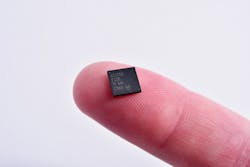TI unveils first ultra-low power dual-band wireless MCU in production
Expanding the functionality of Internet of Things (IoT) networks, Texas Instruments announced availability for mass production of the industry's lowest-power dual-band wireless microcontroller (MCU) supporting Sub-1 GHz and Bluetooth® low energy connectivity on a single chip. As part of TI's pin-to-pin and software compatible SimpleLink™ ultra-low power platform, the new SimpleLink dual-band CC1350 wireless MCU enables developers to move from a three-chip solution to a tiny single chip, while reducing design complexity, saving power, cost and board space. The CC1350 wireless MCU offers a range of up to 20 km on a coin cell battery for building and factory automation, alarm and security, smart grid, asset tracking and wireless sensor network applications.
Designed for low-power wide area networks (LPWAN), the CC1350 wireless MCU features:
- Dual-band connectivity that expands the functionality of a Sub-1 GHz network with Bluetooth low energy implementations such as beaconing, over-the-air updates, smart commissioning, remote displays and more.
- Long-range connectivity paired with ultra-low power consumption that offers a sleep current of 0.7 uA which allows for more than 10 years of battery life.
- Enhanced integration in a tiny wireless MCU that combines a Sub-1 GHz transceiver and Bluetooth low energy radio, as well as an ARM® Cortex®-M3 core in a single, Flash-based, 4x4 mm QFN package.
Developers can get started in minutes with the low-cost SimpleLink CC1350 wireless MCU LaunchPad™ development kit or connect sensors to the cloud in minutes with the SimpleLink CC1350 SensorTag demo kit supported by TI's Code Composer Studio™ integrated development environment (IDE) and IAR Embedded WorkBench®. Additionally, TI has simplified development by providing multiple software options including point-to-point communication examples with EasyLink, a wireless M-Bus protocol stack leveraging TI RTOS, as well as the BLE-Stack 2.2 software development kit (SDK) which supports Bluetooth 4.2 specifications. Developers will also have access to online training and E2E™ community support to help ease their design process.
>>For more information, click here

